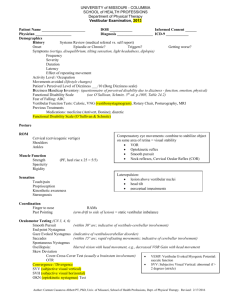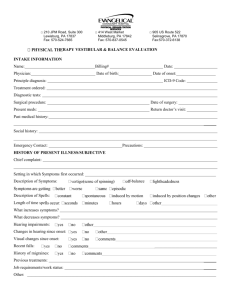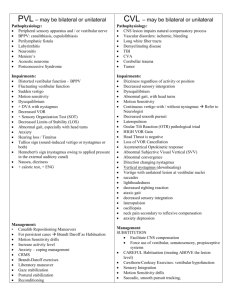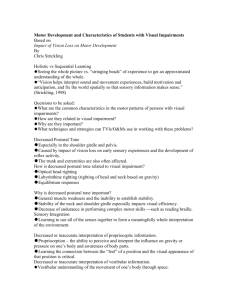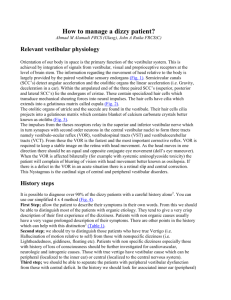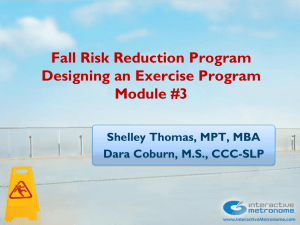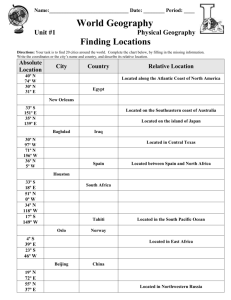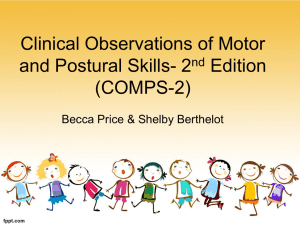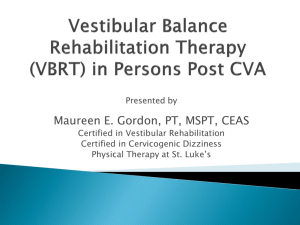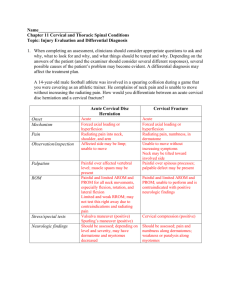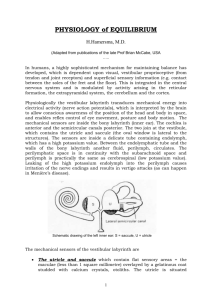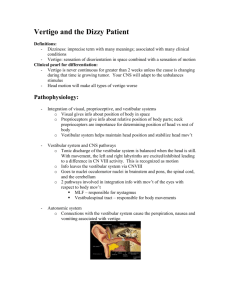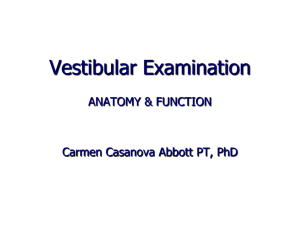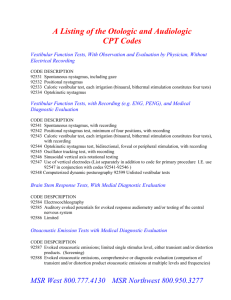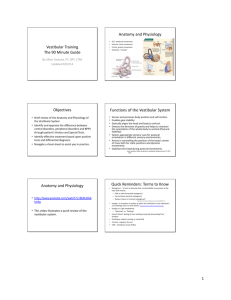Pediatric Vestibular Examination
advertisement
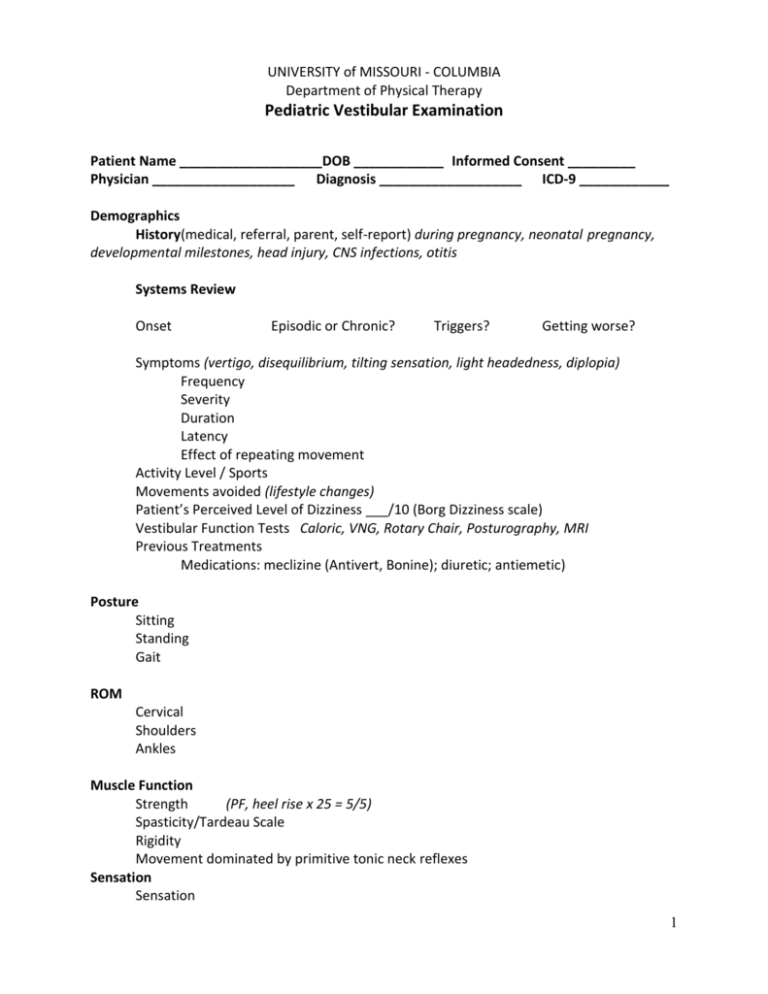
UNIVERSITY of MISSOURI - COLUMBIA Department of Physical Therapy Pediatric Vestibular Examination Patient Name ___________________DOB ____________ Informed Consent _________ Physician ___________________ Diagnosis ___________________ ICD-9 ____________ Demographics History(medical, referral, parent, self-report) during pregnancy, neonatal pregnancy, developmental milestones, head injury, CNS infections, otitis Systems Review Onset Episodic or Chronic? Triggers? Getting worse? Symptoms (vertigo, disequilibrium, tilting sensation, light headedness, diplopia) Frequency Severity Duration Latency Effect of repeating movement Activity Level / Sports Movements avoided (lifestyle changes) Patient’s Perceived Level of Dizziness ___/10 (Borg Dizziness scale) Vestibular Function Tests Caloric, VNG, Rotary Chair, Posturography, MRI Previous Treatments Medications: meclizine (Antivert, Bonine); diuretic; antiemetic) Posture Sitting Standing Gait ROM Cervical Shoulders Ankles Muscle Function Strength (PF, heel rise x 25 = 5/5) Spasticity/Tardeau Scale Rigidity Movement dominated by primitive tonic neck reflexes Sensation Sensation 1 Limb Proprioception Limb Kinesthetic Awareness Cervical Joint Position Error Test Age Equivalency Motor Development Tonic Neck Reflexes Head Righting Equilibrium Responses Standardized tests of motor development Alberta Infant Motor Scale (AIMS); Peabody Developmental Motor Skills (PDMS); Bruininkks-Oseretsky Test of Motor Proficiency (BOTMP) Coordination Finger to nose Rapid Alternating Movements (RAMS) Past Pointing (arm drift to side of lesion) = static vestibular imbalance Oculomotor Testing (CN 3, 4, 6) Smooth Pursuit (within 30º arc; indicative of vestibule-cerebellar involvement) End point Nystagmus Gaze Evoked Nystagmus (indicative of vestibulocerebellar disorder; hold for 10 sec) Saccades (within 15º arc; rapid refixating movements; indicative of cerebellar involvement) Spontaneous Nystagmus (unidirectional – PVL; changing directions –CNS) Oscillopsia (blurred vision with head movement, e.g., decreased VOR Gain with head movement) Diplopia Skew Deviation Cover-Cross-Cover Test (usually a brainstem involvement) Ocular Tilt Response (head tilt, skew deviation of the eyes, torsion of eyes) Convergence / Divergence SVV (subjective visual vertical) SVH (subjective visual horizontal) OKN Test (optokinetic nystagmus) VOR VOR Gain Maintained fixation (30º neck flexion) horizontal ______ vertical ______ Head Thrust Test (30º neck flexion, unpredictable head thrust) Head Shake Test (30°neck flexion, passive rotation 20x, EC) VOR Cancellation Dynamic Visual Acuity # lines lost _____ Post Rotary Nystagamus Test (3 years of age; 30º neck flexion, > 2 lines lost is indicative of vestibular hypofunction) (2 years of age; 30°neck flexion, 10 rotations at 2 Hz, switch sides) 2 Positional Maneuvers Motion Sensitivity Score (dizziness, nausea, other signs of discomfort) Vertebral Artery Dix Hallpike Test PSCC ASCC HSCC Supine Roll Test Spontaneous nystagmus ______ Sit to Supine Test: ______ Static Balance (Vestibulospinal Reflex –VSR) Sitting Standing Romberg (EO / EC) Sharpened Romberg (Tandem, EO / EC; 4 years of age) Single Leg Stance (EO / EC) Perturbation: Postural Stress Test: (“Push and Release”: therapist gives a sustained push from the front, back, sides, so the person is close to their limit of stability, then suddenly release the push.) Modified CTSIB - Clinical Test of Sensory Interaction in Balance (“Foam & Dome” correlates with Sensory Organization Test (SOT); observe sway, time position is held, movement strategy) or Pediatric Clinical Test of Sensory Interaction for Balance (P-CTSIB; ordinal or sensory system scale) SOT (Equitest) Dynamic Balance (self-initiated movement) Functional Reach (multidirectional, up to limits of stability; forward reach 6.7-11.9” in 5-15 year olds) Fukuda Step Test o >50 cm forward; 30º angle turn = 60% probability of peripheral lesion o 90º turn = 90% probability of peripheral lesion Functional Performance Berg Pediatric Balance Scale (Franjoine MR, 2003; 5-15 year olds with mild to moderate motor impairment) Habitual Gait Speed TandemWalk (10’, EC; with a BVL patient will lose balance with EO) Functional Gait Assessment (30/30; contains vestibular items) Timed Up & Go Test (> 10 sec indicates fall risk: independent community ambulator) Five Times Sit-to-Stand Test (> 10 sec indicates fall risk: independent community ambulator) Movement Patterns/Locomotor Skills Kicking/Striking/Catching/Throwing Running 3 Balance Beam Walk; Tandem Walk on 10” line Jumping Hopping Galloping Skipping Physical Therapy Assessment Peripheral Central Mixed Vestibular Dysfunction (static and dynamic postural stability; oculomotor function, vestibular function, motor development, fall risk) Treatment Rendered Repositioning Maneuver Precautions Safety Symptom Exacerbation Symptom Triggers Home Exercise Program Positioning Play Activities Oculomotor Drills Postural Drills Physical Activity Sports Level Goals Gaze stabilization Postural stability Dissociation of head from trunk Habituation Return to full school, home, play and sport level Treatment Plan / Recommendations Home School Play F/U Referrals Therapist ___________________________________ Date __________ 4
